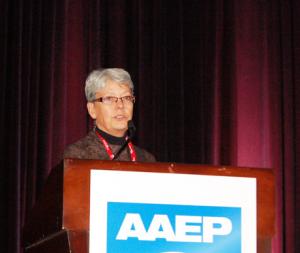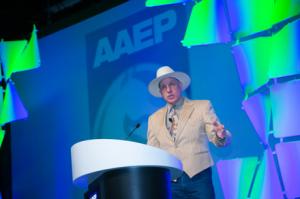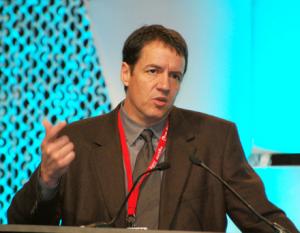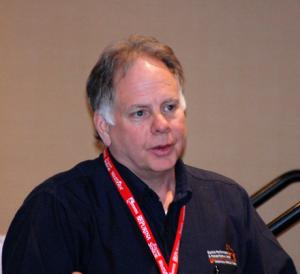The 59th Annual Convention of the American Association of Equine Practitioners, held December 7 – 11, 2013 in Nashville, Tenn., attracted 6,592 veterinary professionals, guests and exhibitors, making it the fourth largest convention in the AAEP’s history. The holiday décor and tropical forest atmosphere of the Gaylord Opryland Resort and Convention Center in Nashville, TN provided the background for an intense sharing of information about equine medicine and health care.
In addition to four days of education covering topics ranging from pain management to sport horse medicine, the Convention featured famed horse trainer Buck Brannaman as the keynote speaker. Renowned lameness expert Dr. Sue Dyson delivered the prestigious Frank J. Milne State-of-the-Art Lecture.
The topic for keynote speaker Buck Brannaman was “Horses and Life – It’s All the Same to Me.” He began, “Being a horse vet is a dangerous job!” He explained that most of what equine vets do is work around a horse’s head and their feet, both particularly dangerous places to be. To keep things safe for the horse owner and the professionals who work on their horses, Buck emphasized preparing horses to cope with every eventuality. He talked about the differences between everyday handling by horse owners and the handling that veterinarians and farriers must do in the capacity of their jobs.
Understanding horse behavior is critical to understanding how to prepare a horse to cope with various situations. He described some of the misperceptions people hold of how a horse sees the world. “Humans like to anthropomorphize the animals, but horses process things one way--they do it the way things work in a herd and how they see other horses in the herd. He talked about relationships and dominance in a herd, and how it is maintained. Just as an alpha horse can keep the herd peaceful and calm without necessarily showing overt aggression, the quest for a good relationship between horse and human is the idea of giving a horse a peaceful place of calm. So, there is a joint responsibility between horse owner and veterinarian to give a horse its best chance at health care by having the horse cooperate and tolerate being poked, prodded, and manipulated, even when there is some pain involved.
Sunday morning’s sessions, Ethics in Veterinary Medicine, included ethical professional conduct, societal obligations to horses and owners, equine welfare, and lessons learned from medical business ethics. David Ramey, DVM included a section in his paper on legislation pertaining to horse welfare and abuse. “There are numerous examples of society’s interest in the ethical treatment of horses. The failure of the Tennessee Walking Horse industry to protect horse welfare has led to Federal legislation banning the practice of ‘soring’ [referring to the Horse Protection Act].
The Ambulatory Practice sessions covered a wide range of issues, many starting with “How to…” Stephen O’Grady, DVM presented “How to Evaluate the Equine Hoof Capsule,” in great photographic detail that would also interest farriers. “Evaluation of the hoof capsule during the lameness examination will provide additional information as to the etiology and treatment of the lameness, but will also serve as a guideline to apply therapeutic farriery and other preventive measures to maintain a healthy hoof,” O’Grady concluded. This dovetailed nicely with Sunday afternoon’s Lameness section: “Diagnostic Analgesia, Medications, and Physiologic Effects.”
On Monday, Dr. Sue Dyson, renowned in equine orthopedics, gave the Frank J. Milne State-of-the-Art Lecture on “Equine Lameness: Clinical Judgment Meets Advanced Diagnostic Imaging.” Furnishing information for practitioners to efficiently diagnose lameness, she focused on three key areas: recognition of lameness, new knowledge about the limitations of diagnostic analgesia, and the value of MRI in diagnosing foot-related lameness.
Tuesday’s sessions moved to Medicine Updates: Diagnostics and Treatments, In-Depth: Geriatric Medicine/Metabolics, and In-Depth: Reproductive Endocrinology. Presenting his paper “Dietary Management of Endocrine Disorders in the Older Horse,” Dr. Raymond Goer noted that “the proportion of the horse population regarded as ‘older’ or ‘aged’ has increased in recent years.” He described selected aspects of aging in horses, including digestive function, body condition; management of obesity; pasture access, and dietary supplements. He covered topics that owners of older horses may have to deal with, such as PPID and equine metabolic syndrome (EMS). “A primary clinical concern with both PPID and EMS is laminitis…” he wrote.
Tuesday afternoon’s sessions covered “How to Take and Interpret Radiographs of the Young Performance Horse.” Erin McKerney presented her co-authored paper “Fatal Musculoskeletal Injuries of the Metacarpolphalangeal and Metatarsophalangeal (Fetlock) Joings in California Racehorses: 139 Cases.” Her study analyzed postmortem examination records for deceased California racehorses that incurred a fatal fetlock injury, which comprised 50% of total injuries. Proximal sesamoid bone fracture was the most common cause of fetlock injury, with 66% showing a grossly visible pre-existing lesion. “The high prevalence of California racehorses that are euthanized because of fetlock breakdown injuries makes possible pattern recognition of fracture configuration and pre-existing lesions…that can aid in early detection and catastrophic injury prevention.”
These sessions provided the perfect segue into Wednesday morning’s session: “Racing Related Lameness.” Dr. Christopher E. Kawcak further discussed the pathological processes that occur in the third metacarpal condyles, common sites of injury in the Thoroughbred racehorse.
Susan Stover, DVM, PhD, Diplomate ACVS, covered “Diagnostic workup of Upper-Limb Stress Fractures and Proximal Sesamoid Bone Stress Remodeling.” “Racehorses are susceptible to over-use injuries from repetitive motions incurred during intense training and competition,” she said. “Lameness varies markedly in severity between affected horses, from only a change in demeanor to non-weight bearing.” She showed in detail how the spine of the scapula can be palpated to detect scapular stress fractures.
The next How-To Session focused on “Field Anesthesia and Pain Management.” Alonso Guedes covered “How to Provide Pain Relief to Laminitis in the Field,” and Moderator John A.E. Hubbbell discussed “How to Produce 20 minutes of Equine Anesthesia in the Field” and “How to Safely Anesthetize a Horse for 60 Minutes or more in the Field.”
A social media dry lab offered practitioners a hands-on opportunity to learn how to develop and implement a social media strategy for their practice. During “The Business of Practice” sessions, practitioners learned the key communication skills necessary to strengthen client relationships and build success.
An expanded student program helped facilitate the transition from veterinary school to practice, and a professional development course addressed important topics facing impending graduates.
The AAEP’s 60th Annual Convention will take place in Salt Lake City, Utah, Dec. 6 – 10, 2014. More information is available at www.aaep.org.
In addition to four days of education covering topics ranging from pain management to sport horse medicine, the Convention featured famed horse trainer Buck Brannaman as the keynote speaker. Renowned lameness expert Dr. Sue Dyson delivered the prestigious Frank J. Milne State-of-the-Art Lecture.
The topic for keynote speaker Buck Brannaman was “Horses and Life – It’s All the Same to Me.” He began, “Being a horse vet is a dangerous job!” He explained that most of what equine vets do is work around a horse’s head and their feet, both particularly dangerous places to be. To keep things safe for the horse owner and the professionals who work on their horses, Buck emphasized preparing horses to cope with every eventuality. He talked about the differences between everyday handling by horse owners and the handling that veterinarians and farriers must do in the capacity of their jobs.
Understanding horse behavior is critical to understanding how to prepare a horse to cope with various situations. He described some of the misperceptions people hold of how a horse sees the world. “Humans like to anthropomorphize the animals, but horses process things one way--they do it the way things work in a herd and how they see other horses in the herd. He talked about relationships and dominance in a herd, and how it is maintained. Just as an alpha horse can keep the herd peaceful and calm without necessarily showing overt aggression, the quest for a good relationship between horse and human is the idea of giving a horse a peaceful place of calm. So, there is a joint responsibility between horse owner and veterinarian to give a horse its best chance at health care by having the horse cooperate and tolerate being poked, prodded, and manipulated, even when there is some pain involved.
Sunday morning’s sessions, Ethics in Veterinary Medicine, included ethical professional conduct, societal obligations to horses and owners, equine welfare, and lessons learned from medical business ethics. David Ramey, DVM included a section in his paper on legislation pertaining to horse welfare and abuse. “There are numerous examples of society’s interest in the ethical treatment of horses. The failure of the Tennessee Walking Horse industry to protect horse welfare has led to Federal legislation banning the practice of ‘soring’ [referring to the Horse Protection Act].
The Ambulatory Practice sessions covered a wide range of issues, many starting with “How to…” Stephen O’Grady, DVM presented “How to Evaluate the Equine Hoof Capsule,” in great photographic detail that would also interest farriers. “Evaluation of the hoof capsule during the lameness examination will provide additional information as to the etiology and treatment of the lameness, but will also serve as a guideline to apply therapeutic farriery and other preventive measures to maintain a healthy hoof,” O’Grady concluded. This dovetailed nicely with Sunday afternoon’s Lameness section: “Diagnostic Analgesia, Medications, and Physiologic Effects.”
On Monday, Dr. Sue Dyson, renowned in equine orthopedics, gave the Frank J. Milne State-of-the-Art Lecture on “Equine Lameness: Clinical Judgment Meets Advanced Diagnostic Imaging.” Furnishing information for practitioners to efficiently diagnose lameness, she focused on three key areas: recognition of lameness, new knowledge about the limitations of diagnostic analgesia, and the value of MRI in diagnosing foot-related lameness.
Tuesday’s sessions moved to Medicine Updates: Diagnostics and Treatments, In-Depth: Geriatric Medicine/Metabolics, and In-Depth: Reproductive Endocrinology. Presenting his paper “Dietary Management of Endocrine Disorders in the Older Horse,” Dr. Raymond Goer noted that “the proportion of the horse population regarded as ‘older’ or ‘aged’ has increased in recent years.” He described selected aspects of aging in horses, including digestive function, body condition; management of obesity; pasture access, and dietary supplements. He covered topics that owners of older horses may have to deal with, such as PPID and equine metabolic syndrome (EMS). “A primary clinical concern with both PPID and EMS is laminitis…” he wrote.
Tuesday afternoon’s sessions covered “How to Take and Interpret Radiographs of the Young Performance Horse.” Erin McKerney presented her co-authored paper “Fatal Musculoskeletal Injuries of the Metacarpolphalangeal and Metatarsophalangeal (Fetlock) Joings in California Racehorses: 139 Cases.” Her study analyzed postmortem examination records for deceased California racehorses that incurred a fatal fetlock injury, which comprised 50% of total injuries. Proximal sesamoid bone fracture was the most common cause of fetlock injury, with 66% showing a grossly visible pre-existing lesion. “The high prevalence of California racehorses that are euthanized because of fetlock breakdown injuries makes possible pattern recognition of fracture configuration and pre-existing lesions…that can aid in early detection and catastrophic injury prevention.”
These sessions provided the perfect segue into Wednesday morning’s session: “Racing Related Lameness.” Dr. Christopher E. Kawcak further discussed the pathological processes that occur in the third metacarpal condyles, common sites of injury in the Thoroughbred racehorse.
Susan Stover, DVM, PhD, Diplomate ACVS, covered “Diagnostic workup of Upper-Limb Stress Fractures and Proximal Sesamoid Bone Stress Remodeling.” “Racehorses are susceptible to over-use injuries from repetitive motions incurred during intense training and competition,” she said. “Lameness varies markedly in severity between affected horses, from only a change in demeanor to non-weight bearing.” She showed in detail how the spine of the scapula can be palpated to detect scapular stress fractures.
The next How-To Session focused on “Field Anesthesia and Pain Management.” Alonso Guedes covered “How to Provide Pain Relief to Laminitis in the Field,” and Moderator John A.E. Hubbbell discussed “How to Produce 20 minutes of Equine Anesthesia in the Field” and “How to Safely Anesthetize a Horse for 60 Minutes or more in the Field.”
A social media dry lab offered practitioners a hands-on opportunity to learn how to develop and implement a social media strategy for their practice. During “The Business of Practice” sessions, practitioners learned the key communication skills necessary to strengthen client relationships and build success.
An expanded student program helped facilitate the transition from veterinary school to practice, and a professional development course addressed important topics facing impending graduates.
The AAEP’s 60th Annual Convention will take place in Salt Lake City, Utah, Dec. 6 – 10, 2014. More information is available at www.aaep.org.














